| Botanical Name |
|
| Family |
Asteraceae - The daisy family. |
| Pronunciation |
|
| Common Name(s) |
|
| Plant Group |
- Succulent A plant having fleshy stems or leaves often adapted to dry conditions.
|
| Plant Size |
- Small
| Tree | 4m to 8m |
| Shrub | 50cm to 75cm |
| Perennial/ground cover | 10cm to 20cm |
| Bulb | 20cm to 30cm |
| Succulent | 10cm to 20cm |
|
| Position |
- Light or Dappled Shade Found below trees with sparse, open foliage. Ideal for the protection of herbaceous plants.
- Partial Shade The area is in shade for part of the day and in full sun for part of the day.
- Sun The area is in full sun for all or most of the day, all year round.
|
| General Information |
- Drought Tolerance: High The plant is well adapted to arid conditions; it can survive long periods of drought and high temperatures without extra water.
- Evergreen Plants that have leaves all year round.
- Frost: Half-hardy The plant is able to survive low temperatures and some frost but requires protection against severe frost.
- Sand tolerant Plants adapted to survive in nutrient poor, very sandy soils.
- Water Wise Plant species originating from low rainfall regions that require less water to survive and thrive than other plant species.
|
| Specific Information |
Othonna capensis is a low-growing, succulent ground cover with a spreading habit. The finger-like, blue-grey leaves are spirally arranged and become tipped with maroon in dry conditions. It is drought-tolerant once established and if protected will tolerate light frost. It blooms irregularly throughout the year. Grows successfully in both winter and summer rainfall regions.
|
| Ad Break |
|
| Flowers |
| Description |
small, daisy flowers on long, slender stems held well above the foliage
|
| Season |
- All Year Plants will seldom bloom for the entire season as given in the list, but should flower during a period within these parameters.
|
| Colour |
|
| Growth Rate |
- Very Fast Specifying growth rate can be very misleading as there is considerable variation of growth rate depending on type and species of plant, available water, supplementary feeding, mulching and general care, as well as the plants suitability and adaptability to the garden environment.
|
| Plant Uses |
- Attracts bees, butterflies or other insects This plant attracts insects which can be food for birds or other creatures in your garden.
- Border A strip of ground, at the edge of a driveway or path in which ornamental plants or shrubs are planted.
- Container Trees, shrubs and ornamental species that can adapt to growing in a restricted environment.
- Edging A low growing plant that provides softness or definition to the edges of a bed or walkway.
- Filler Either a fast growing tree or shrub used temporarily to fill in an area while the permanent plants grow to a desired size, or a plant used to fill gaps in borders or beds.
- Ground Cover Low-lying plants that spread fast, require minimal maintenance, and cover large expanses or bare areas between bulbs or shrubs. They provide protection from erosion and drought and improve the visual appearance of the garden.
- Interplanting Arranging and planting plants in the garden that have different blooming times and habits of growth, extending the amount of time in which the area is in flower.
- Retaining Walls Shallow rooted plants for cascading over dry stone walls or planting in hollow spots in retaining blocks.
- Rock Garden An area constructed of larger rocks, arranged naturally, to emphasise the use of stones as a main element. Generally plants used do not need a lot of care.
- Stabilize Banks Plant is used to prevent soil erosion because their roots will form a mat that stabilizes the soil and keeps it from washing away in heavy rains.
- Suitable for coastal gardens Plants adapted to dry, sandy soil, forceful wind, limited rainfall and intense sunlight.
- Wild Garden An indigenous garden planted for the benefit of wildlife and birds. Provides food, water, a variety of mini-biomes and no poisonous chemicals are used.
|
| Distribution and Habitat |
endemic to the Eastern Cape Province in semi-arid Karoo scrub and dry, rocky flats, often in the partial protection of surrounding vegetation or rocks
|
| Planting Suggestions |
Othonna capensis needs very little care and establishes itself easily in most soils, the proviso being good drainage. Wet feet will cause rot and disease. Grown in full sun or with just a little shade, it retains its blue-grey colouring and stiff, fingerlike foliage. If grown inside or with little direct sunlight, the leaves become greener, skinny and much longer and are unable to hold themselves erect.
|
| Lorraine's Garden Notes |
2013: In my Bathurst garden, in poor, alkaline soil and dry conditions, this plant has flowered generously, seeded lavishly and germinated profusely, often at quite a distance from the original site.
2014: Othonna capensis has become so invasive that I have banished it to the veld garden where harsh conditions and natural grasses will hopefully keep it in check. Despite constant removal of seedlings in the garden beds, it is still coming up in large numbers, often hiding under shrubs.
The plant is not invasive in cooler regions.
|
| Medicinal Uses |
|
| Ad Break |
|



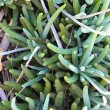
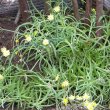
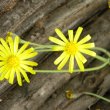
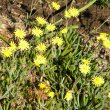
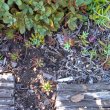


Discuss this plant
Share knowledge, ask a question or give an experience.